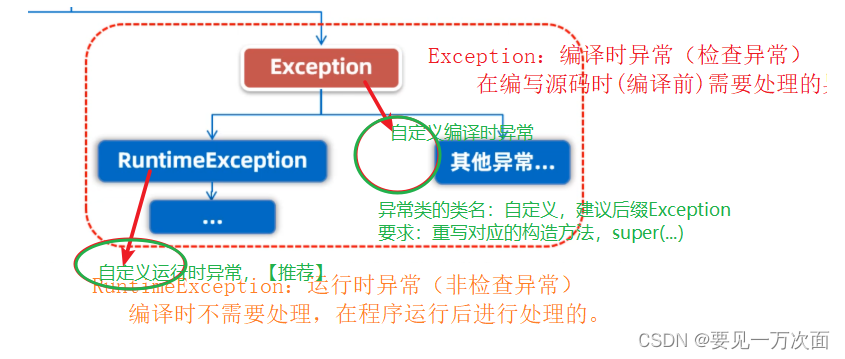面向对象三大特性
面向对象三大特性:封装、继承、多态。
- 封装:将类或接口实现细节包装、隐藏起来。
具体事例:JavaBean - 继承:通过extends关键字,让一个类和另一个类创建父子关系。
public class 父类 {
public void info() {}
}
public class 子类 extends 父类 {
// 重写
@Override
public class info() {}
}
- 多态:同一个行为可以具有不同的形态。
1)对象多态(引用多态):
父类 变量 = new 子类();
接口 变量 = new 子类();
2)行为多态(方法多态):2个父类,执行的不同的行为
父类 变量1 = new 子类();
父类 变量2 = new 子类();
变量1.方法名();
变量2.方法名();
3)重载:在同一个类中方法名相同,参数类表不同的多个方法。
public class 类名{
public void 方法() {
}
public void 方法(String s) {
}
}
面试题:
OOP(object oriented programming),即面向对象编程
面向对象具有四大特性,分别是
1.抽象:将一些事物的共性抽离出来归为一个类。
如对于动物,具有生命体征、活动能力等区别于其它事物的共同特征
2.封装:有选择地隐藏和暴露数据和方法
比如有U盘这个类,我希望隐藏内部组成和实现,只暴露USB接口以供使用
3.继承:子类可以直接使用父类的部分数据和方法,可以有选择的扩展
比如鸟是动物,但鸟扩展了飞行的能力。
4.多态:同一类的对象调用相同方法可以表现出不同的行为
比如动物实现了say()方法,猴子、马等动物重写了say()方法来表现不同的交流语言。"
集合操作
- 常见集合:
单列:List、Set
多例:Map - List基本操作
// 1. 创建List集合
List<String> list = new ArrayList<>();
// 2. 添加
list.add("abc");
// 3. 遍历
// 3.1 for循环
for(int i = 0; i < list.size(); i++) {
System.out.println("索引:" + i);
System.out.println("item"+ list.get(i));
}
// 3.2 增强for
for(String s : list) {
System.out.println(s);
}
// 3.3 迭代器
Iterator<String> iterator = list.iterator();
while(iterator.hasNext()) {
String next = iterator.next();
System.out.println(next);
}
// 3.4 lambda
list.forEach(s -> System.out.println(s));
- Set基本操作
// Set没有索引
// 1. 创建Set集合
Set<String> stringSet = new HashSet<>();
// 2. 添加
stringSet.add("李四");
// 3. 遍历 set没有索引
// 3.1. 增强for
for(String s : stringSet) {
System.out.println(s);
}
// 3.2. 迭代器
Iterator<String> iterator1 = stringSet.iterator();
while (iterator1.hasNext()) {
String next = iterator1.next();
System.out.println(next);
}
// 3.3. lambda
stringSet.forEach(s -> {
System.out.println(s);
});
- Map基本操作
// 1. 创建Map集合
Map<Integer,String> map = new HashMap<>();
// 2. 添加
map.put(1,"a");
map.put(2,"b");
// 3. 遍历
// 3.1 增强for
for (Map.Entry<Integer,String> entry : map.entrySet()) {
System.out.println(entry.getKey());
System.out.println(entry.getValue());
}
for(Integer key : map.keySet()) {
System.out.println(key);
System.out.println(map.get(key));
}
// 3.2 迭代器
Iterator<Map.Entry<Integer,String>> iterator2 = map.entrySet().iterator();
while (iterator2.hasNext()) {
Map.Entry<Integer, String> next = iterator2.next();
System.out.println(next.getKey());
System.out.println(next.getValue());
}
Iterator<Integer> iterator3 = map.keySet().iterator();
while (iterator3.hasNext()) {
Integer key = iterator3.next();
String value = map.get(key);
System.out.println(key);
System.out.println(value);
}
// 3.3 lambda
map.forEach((key, value) -> {
System.out.println(key);
System.out.println(value);
});
map.keySet().forEach(key -> {
String value = map.get(key);
System.out.println(key);
System.out.println(value);
});
map.entrySet().forEach(entry -> {
System.out.println(entry.getKey());
System.out.println(entry.getValue());
});
}
集合总结

异常
-
什么是异常?
在编写或运行时程序的异常情况,统称为异常。 -
异常的体系结构【重点】

-
如何处理异常【重点】
抛出异常:
public void 方法名() throws 异常类名, 异常类名2{ //声明异常
...;
//抛出异常
if()
throw new 异常类名();
//继续抛出
if()
throw new 异常类名2();
}
捕获异常:
try {
//代码,可能存在异常
方法名();
} catch (异常类名 变量) {
//异常变量,获得具体的异常信息
} catch (异常类名2 变量) { //catch 先处理子异常,再处理父异常(大异常)
//异常变量,获得具体的异常信息
} .... {
} finally {
//最终(正常/异常 都执行)
}
具体代码:
public class TestException {
public static void main(String[] args) {
try {
info(1);
} catch (SQLException e) {
System.out.println("2:" + e.getMessage());
} catch (IOException e) {
System.out.println("3:" + e.getMessage());
} finally {
System.out.println("4: 最终的!");
}
}
public static void info(int num) throws IOException, SQLException {
if (num == 1) {
throw new IOException();
}
if (num == 2) {
throw new SQLException();
}
System.out.println("1. info方法调用!");
}
}
- 自定义异常

代码实现:
StudentException类【自定义】
public class StudentException extends Exception{
public StudentException() {
}
public StudentException(String message) {
super(message);
}
public StudentException(String message, Throwable cause) {
super(message, cause);
}
public StudentException(Throwable cause) {
super(cause);
}
public StudentException(String message, Throwable cause, boolean enableSuppression, boolean writableStackTrace) {
super(message, cause, enableSuppression, writableStackTrace);
}
}
UserException 类【自定义】
public class UserException extends RuntimeException {
public UserException() {
}
public UserException(String message) {
super(message);
}
public UserException(String message, Throwable cause) {
super(message, cause);
}
public UserException(Throwable cause) {
super(cause);
}
public UserException(String message, Throwable cause, boolean enableSuppression, boolean writableStackTrace) {
super(message, cause, enableSuppression, writableStackTrace);
}
}
TestCustom测试类
public class TestCustom {
public static void main(String[] args) {
try {
info(2);
} catch (StudentException e) {
throw new RuntimeException(e);
} finally {
System.out.println("最终");
}
}
public static void info(int num) throws StudentException {
if(num == 1) {
throw new StudentException("学生异常");
}
if(num == 2) {
throw new UserException("用户异常");
}
System.out.println("info调用成功");
}
}
可变参数
- 语法
类型… 变量名
public void info(String... strs) {}
- 使用
public static void main(String[] args) {
// 可变参数:实际参数的个数可以改变
info("张三", "b","c","d");
// 对象数组: 在可变参数中被打散作为实参进行传递
String[] arr = {"1","2","3"};
info("李四", arr);
}
// 可变参数语法: 类型... 变量名
public static void info(String name, String... strs) {
// 可变参数的变量相当于数组
System.out.println("姓名:" + name);
System.out.println(Arrays.toString(strs));
}
- 注意事项
可变参数只能在参数列表中的最后一项
参数列表中只能存在一个可变参数,否则会报错
// public static void info(String name, String... strs) 对
// public static void info(String name, String... strs, int age) 错
// public static void info(String... names, String... strs) 错
}






















 3823
3823











 被折叠的 条评论
为什么被折叠?
被折叠的 条评论
为什么被折叠?








